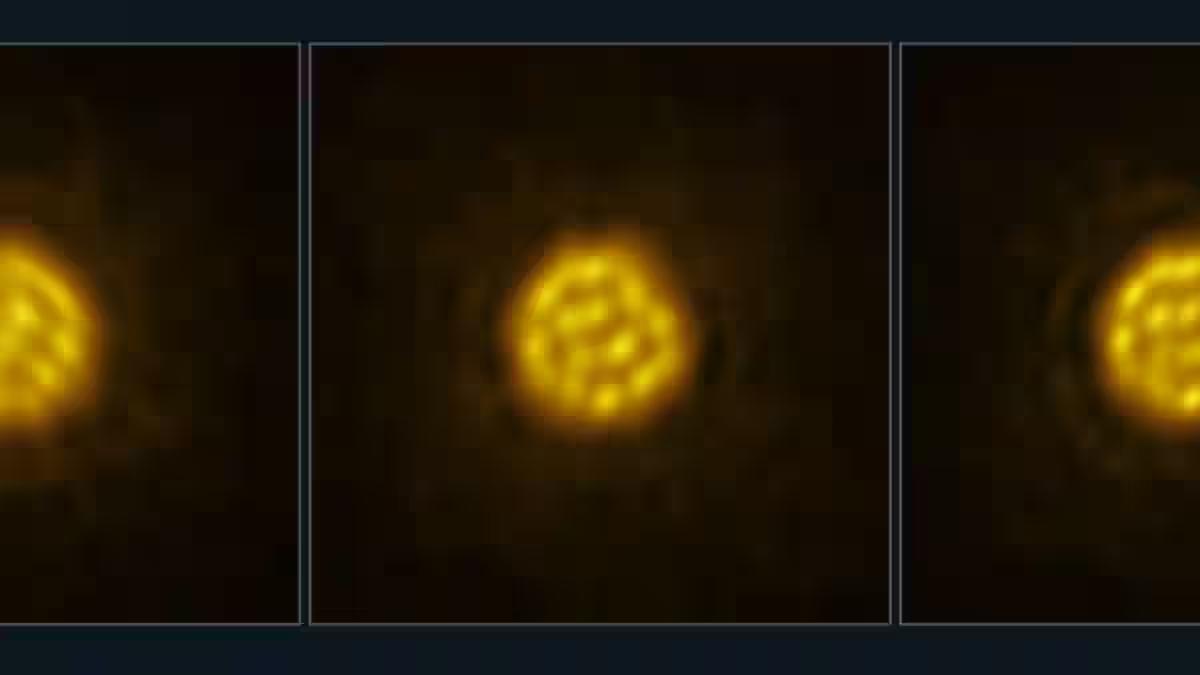Gas bubbles, each one 75 times the size of our Sun, are boiling on the surface of the distant star R Doradus, offering an unprecedented glimpse into the convective processes of a massive red giant.
This discovery, achieved through high-resolution imaging by the Atacama Large Millimeter/submillimeter Array (ALMA) telescope, represents a significant leap in our understanding of stellar dynamics, particularly in the final stages of stellar evolution.
R Doradus, a red giant star located approximately 180 light-years away in the constellation Dorado, represents one of the most intriguing objects of study in modern astronomy. With a size about 350 times that of our Sun, R Doradus is in the final stages of its stellar lifecycle, expanding and evolving in ways that are starkly different from our main-sequence Sun.
This star has become the focus of a groundbreaking study that has provided unprecedented insights into the processes occurring on such colossal celestial bodies.
The red giant phase of a star’s life occurs when it has exhausted the hydrogen fuel in its core. The star then begins to burn hydrogen in a shell surrounding the core, leading to a dramatic increase in size.
During this phase, stars like R Doradus swell to many times their original dimensions and undergo complex changes in their outer layers.
These changes result in the creation of large-scale convective cells, which can manifest as enormous gas bubbles on the star’s surface. Studying these phenomena offers valuable insights into the final stages of stellar evolution and the dynamics of massive stars.
Revolutionary Observations with ALMA
The recent observations of R Doradus have marked a significant milestone in astronomical research. Utilizing the Atacama Large Millimeter/submillimeter Array (ALMA) telescope in Chile, astronomers were able to capture detailed images of the star’s surface over a period of two weeks.
This is the first time humanity has been able to directly image the convection processes on a star other than our Sun with such clarity and detail.
Images of a star that is 178 light years away reveal it is covered in bubbles that are 75 times the size of our sun.
— New Scientist (@newscientist) September 12, 2024
Read more: https://t.co/n882jOc6Mh pic.twitter.com/NYMX67VS8D
The images obtained reveal that R Doradus is covered in gigantic gas bubbles that are approximately 75 times the size of our Sun.
These bubbles are formed by the star’s convective processes, where hot, buoyant gas rises from the interior and cools as it reaches the surface. This convection process is crucial for the redistribution of heat within the star and plays a key role in its overall structure and evolution.
The study found that the convection cells on R Doradus operate on timescales much shorter than previously expected. This revelation challenges existing theories about stellar convection and suggests that the dynamics of red giants may be more complex than previously understood.
The observations also highlight the immense scale of these convection cells, which far exceed the size of any observed on the Sun.
The Significance of Giant Gas Bubbles in Stellar Evolution
The discovery of such massive gas bubbles on R Doradus has profound implications for our understanding of stellar convection and the lifecycle of red giants.
On the Sun, convection cells—known as granules—are much smaller, with diameters of around 1,000 kilometers (620 miles). These granules are the visible manifestation of the convection process and exhibit a relatively short lifespan of about 20 minutes.
In contrast, the convection cells on R Doradus are vastly larger, with diameters 75 times greater than that of the Sun. This size disparity raises several important questions about the nature of convection in red giants.
For example, the enormous size of the gas bubbles suggests that the convection process in red giants operates on a different scale compared to that of the Sun. This discrepancy could be due to the differences in the star’s size, temperature, and the overall structure of its convective layers.
Moreover, the shorter timescales observed for the convection cells on Gas bubbles imply that the dynamics of these red giants are more rapid and complex than those of smaller stars.
This finding could lead to a reevaluation of existing models of stellar convection and provide new insights into the final stages of stellar evolution. Understanding these processes is crucial for developing accurate models of how stars like R Doradus evolve and how they eventually shed their outer layers to become white dwarfs.
The study of Gas bubbles also underscores the importance of high-resolution observations in astrophysics. The ability to capture detailed images of convection processes on distant stars opens up new avenues for research and enhances our understanding of the diverse phenomena occurring in the universe.
By examining the behavior of massive stars like R Doradus, astronomers can gain valuable insights into the life cycles of stars and the processes that drive their evolution.
The discovery of gas bubbles 75 times larger than our Sun on the surface of R Doradus represents a major advancement in the field of stellar astronomy.
The high-resolution images obtained by the ALMA telescope have provided unprecedented details about the convection processes occurring on this massive red giant star. These findings challenge existing theories and offer new perspectives on the dynamics of red giants and their final stages of evolution.
As we continue to explore the universe and observe distant celestial objects, studies like this one will play a crucial role in expanding our knowledge of the cosmos. By examining the behavior of Gas bubbles, astronomers can gain deeper insights into the complex processes that govern stellar evolution and the nature of the universe itself.
The observations of R Doradus not only enhance our understanding of red giants but also pave the way for future research into the diverse and fascinating phenomena occurring in the stellar realm.
let’s enjoy few years on earth with peace and happiness….✍🏼🙏

